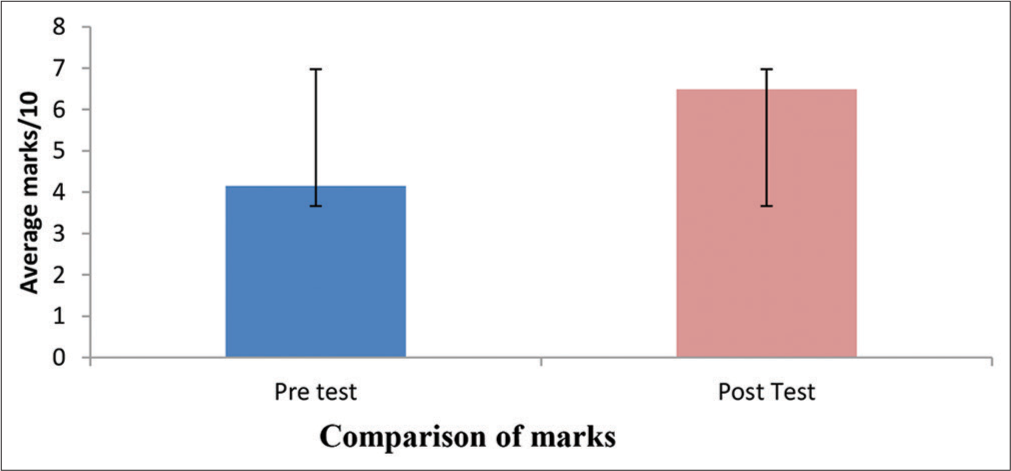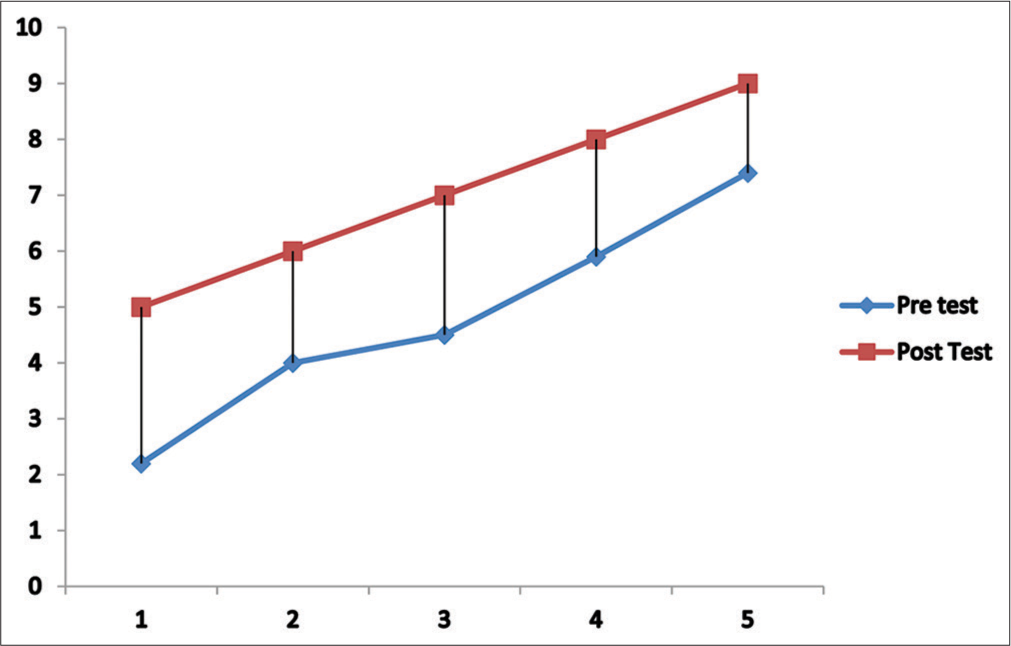Translate this page into:
Introduction to case-based learning: An attempt to integrate topics in biochemistry

*Corresponding author: Sukhraj Kaur, Department of Biochemistry, Government Medical College, Amritsar, Punjab, India. sukhrajkaur2005@yahoo.co.in
-
Received: ,
Accepted: ,
How to cite this article: Kaur S, Sharma R. Introduction to case-based learning: An attempt to integrate topics in biochemistry. Adesh Univ J Med Sci Res 2021;3:91-5.
Abstract
Objectives:
Biochemistry is one of the foundation sciences in the medical curriculum, which has immense importance in understanding the future clinical sciences, but it is generally considered to be a subject of just countless biochemical structures, pathways, and reactions. Conventionally, it was taught by means of didactic lectures, tutorials, and practical classes. These days, the education system is changing to a student-centered teaching–learning process with the use of various innovative teaching methods. Case-based learning (CBL) is one such approach which can make learning more effective and interesting. To generate interest of students in Biochemistry by correlating topics and their clinical application.
Materials and Methods:
After taking permission from the Institutional ethics committee, the students were given didactic lecture on the integration of carbohydrates and lipid metabolisms followed by a test (pre-test). They were then divided into small groups and given case histories which they were to discuss amongst themselves and arrive at a conclusion. These case histories were then discussed one to one with the facilitator. The students were again given a test (post-test).
Results:
There was a significant difference in the marks obtained in pre and post-test. Majority of the students felt it was an enjoyable and effective way of studying Biochemistry. Faculty also gave an encouraging response.
Conclusion:
CBL can be an important way of stimulating the students for self-directed learning and integrating topics of Biochemistry so that they are easily conceptualized.
Keywords
Case-based learning
Biochemistry
Integration
INTRODUCTION
Biochemistry is one of the basic science subjects in the first phase of medical curriculum. In the present day scenario, didactic lectures are the mainstay of teaching biochemistry in most of the medical schools in India. Such a system is teacher-centered with minimal active participation from the students.[1] Teaching basic science subjects is very important for the clinical years that lie ahead.[2] There is a continued need for the development of alternatives to expand learning styles and making it more interesting and fun to learn and study rather than making it boring. Recently, a series of strategies and alternatives are being developed for teaching biochemistry, thus making it more interesting.
Case-based learning (CBL) is one of the innovative alternatives; it may be designed and introduced along with traditional didactic lectures in a way that it creates interest, promotes better understanding, active participation, and self-directed learning. As a whole, learning should be made a pleasurable experience and the student should be motivated to become a life-long learner.
Emerging trend all over the world today are to have a problem-based or case-based student-centered medical curriculum, demanding active participation from the students and facilitating self-directed learning. Many authors are convinced that students learn more effectively if the knowledge and skills they acquire are inserted and contextualized in relevant real-life, problem-based situations.[3] Problem-based learning (PBL) was first introduced by McMasters University medical school as an educational format centered on the discussion, and learning that emanates from a clinically-based problem.[4]
In PBL, students use a trigger for a problem to define their own learning objective, which requires ability to process, and discuss ideas and learn independently. Problem-based learning in its original format of “open inquiry approach” may not be possible in our setup because students entering MBBS courses are coming from a regular way of teaching where they are exposed to only didactic lectures. There is no prior exposure toward self-directed learning and active participation.[4,5] Thus, there is a need for gradual change in the teaching and learning program where formal way of teaching has to continue and the newer approaches have to be introduced along with.
Case-based learning is an educational paradigm closely related to the PBL that uses a “guided inquiry approach” toward solving the problem.[5] Case-based learning main traits are derived from PBL. Case-based learning provides more structure during small group discussions. Cases place events in a context or situation that promote authentic learning and allow students to develop a collaborative team-based approach to their education. The other benefits of CBL are that it develops intrinsic and extrinsic motivation for learning, encourages self-evaluation and critical reflection, integrates knowledge and practice and helps to develop learning skills.[6] Teachers would also benefit from taking CBL to their teaching as they have a chance to reflect upon the learning process when they formulate and introduce the cases to students.[7] The main focus of CBL is to integrate basic science material with clinical science. We have to mainly focus on the way by which we can implement this CBL approach along with the traditional curriculum and also evaluate it in a proper way so that it can be reflected on as a better learning tool.
The present study aimed at introducing CBL with an objective of integrating topics in Biochemistry.
MATERIALS AND METHODS
The students of 1st-year MBBS admitted in the Government Medical College in the year 2017 participated in the study. Permission from the institutional ethics committee was taken for the present study. The current project was discussed with the faculty members of the Department of Biochemistry GMC Amritsar and was asked to participate by preparing the case studies for the students. The feedback form was prepared and validated.
Before the commencement of the study, students were given clear instructions as to what will be done. Out of total of 200 students, 146 gave their consent to participate in the study.
On day 1, all the participating students were given a 1 h didactic lecture integrating Carbohydrate and Lipid metabolism and associated disorder, also they were told about the alteration of these two metabolisms in various disorders.
On day 2, the students were given a pre-test (written examination) to assess their knowledge on the understanding after the didactic lecture.
On subsequent days, when the students came for their practical classes in the Department of Biochemistry they were divided into small groups of eight students each and were given a case history. They were also told about the group dynamics and were asked to assign one of the students as group leader and one was the timekeeper. Each group was given 30 min for discussion amongst themselves to arrive at a conclusion, and another 10 min to answer the questions related to the case study (post-test). All these groups were assigned to the faculty members who acted as facilitators for them. All the participating students were asked to fill the feedback form.
The faculty participated by preparing the case studies and acting as facilitator of the groups.
RESULTS
The performance of the students showed drastic improvement after the session on case studies [Figure 1]. There was a 30% increase in marks when the performance after didactic lecture (pre-test) and after exposure to case study (post-test) was compared amongst each other [Figure 2]. This difference was statistically significant (P < 0.000) [Table 1].

- Comparison of marks of pre and post-test.

- Depicting the mean difference of marks after pre-test and post-test.
| Paired Differences | t | df | Sig. (2-tailed) | ||||||
|---|---|---|---|---|---|---|---|---|---|
| Mean | Std. Deviation | Std. Error Mean | 95% Confidence Interval of the Difference | ||||||
| Lower | Upper | ||||||||
| Pair 1 | One - Two | -2.342 | 0.915 | 0.076 | −2.492 | −2.193 | −30.936 | 145 | 0.000 |
The majority of the student’s feedback in relation to CBL was positive. 49.31% strongly agreed that the session on CBL was interactive. About 61.64% were of the view that knowledge of Biochemistry is helpful in reaching a diagnosis of case history. About 52.73% agreed that CBL is useful for revision of didactic lecture. 65.06% disagreed that CBL took more time to revise the topic already taught. 56.16% wanted that didactic lecture should be followed by case history [Table 2].
| S. No. | Question | Strongly disagree | Disagree | Neutral | Agree | Strongly agree |
|---|---|---|---|---|---|---|
| 1. | Session on CBL was interactive | 0 | 0 | 6 (4.12%) | 72 (46.57%) | 68 (49.31%) |
| 2. | The knowledge of Biochemistry is helpful in reaching a diagnosis of case history | 1 (0.68%) | 0 | 2 (1.36%) | 53 (36.32%) | 90 (61.64%) |
| 3. | CBL is useful for revision of didactic lecture | 2 (1.36%) | 2 (1.36%) | 5 (3.46%) | 77 (52.73%) | 60 (41.09%) |
| 4. | CBL takes more time than required to revise the topic already taught | 22 (15.06%) | 95 (65.06%) | 14 (9.58%) | 9 (6.16%) | 6 (4.14%) |
| 5. | Didactic lecture should be followed by case history | 1 (0.68%) | 2 (1.36%) | 9 (6.16%) | 52 (35.64%) | 82 (56.16%) |
CBL: Case-based learning
The faculty also gave their feedback. All the faculty members agreed that the academic content of the method was stimulating. About 87.5% of the faculty agreed that the response and interest shown by the students was enthusiastic. About 62.5% agreed that CBL motivates students to ask questions and clarify their doubts. All the faculty members agreed that this method of teaching gives opportunity to the students to interact with clinical-based approach and found the overall experience to be interesting. About 75% indicated that CBL methodology was helpful in improving student’s learning skill [Table 3].
| S. No. | Question | Strongly disagree | Disagree | Neutral | Agree | Strongly Agree |
|---|---|---|---|---|---|---|
| 1. | Objective of the teaching method was explained before hand | 8 (100%) | ||||
| 2. | Academic contents of the method was stimulating | 8 (100%) | ||||
| 3. | Response and interest shown by students was enthusiastic | 1 (12.5%) | 7 (87.5%) | |||
| 4. | Case history based teaching motivates students to ask questions and clarify their doubts | 5 (62.5%) | 3 (37.5%) | |||
| 5. | This method of teaching gives opportunity to the students to interact with the clinical based approach | 8 (100%) | ||||
| 6. | Using CBL methodology was helpful in improving student’s learning skills | 2 (25%) | 6 (75%) | |||
| 7. | CBL methodology was overall an interesting experience | 8 (100%) |
CBL: Case based learning
DISCUSSION
In the traditional curriculum learning is teacher-centered where the teacher has the responsibility to teach and what was learned by the students. Lack of clinical relevance makes Biochemistry disinteresting and boring.[8] This view was also given by our students in the additional comment section of the student’s feedback form.
The current CBL module was designed in such a way to integrate topics covered in didactic lectures and after completion of two or more topics, one session on CBL can be done. By this approach, students will be able to retain the knowledge through active participation rather than memorization, develop reasoning strategies, and assume responsibility for learning. In addition, they develop problem-solving skills, clinical judgment, and self-assessment skills and practice applying biochemical knowledge to clinical practice.
Cases helped learners to develop problem-solving skills and collaborative skills that are recognized as key outcome, skills that students will need in their future professional lives. The cases were given to students for small group discussions. The group focused on problem-solving. Facilitators guided the students by way of questions to bring them to the main learning objective. Both students and faculty contributed to the discussion. Mean scores were higher after CBL as compared to didactic lecture, our study showed the same result [Figure 2].
Students undertaking CBL found learning more enjoyable compared with traditional lecture format. Student’s perception indicated that clinical reasoning, diagnostic interpretations, and the ability to think logically was also improved with CBL.[5-10] The present study showed that students performed better in post-CBL session indicating that CBL is an effective method than didactic lecture [Table 1], [Figures 1 and 2]. The utility and effectiveness of this new teaching module have been proven by analyzing student’s feedback form and also teacher’s reflection towards improvement in the teachinglearning process [Tables 2 and 3]. As reported in previous studies[11,12] both teachers and students were satisfied with this kind of teaching and it proves to be an effective tool for learning Biochemistry.
Limitations
The study was done taking into consideration only two topics. It can be designed for more than one pair of topics as the students requested in their feedback.
CONCLUSION
Fundamental knowledge of Biochemistry is important for understanding Medicine. It was evident from pre-test that didactic lectures are non-stimulators for the brain of the students. CBL can be an important way of stimulating the students for self-directed learning and integrating topics of Biochemistry so that they are easily conceptualized.
Acknowledgments
The authors would like to thank the IEC for granting the permission for the conduct of this project. Participation of the students and faculty is acknowledged.
Declaration of patient consent
Patient’s consent not required as there are no patients in this study.
Financial support and sponsorship
Nil.
Conflicts of interest
There are no conflicts of interest.
References
- The effect of integrated teaching with case based learning (CBL) in the biochemistry of undergraduate medical curriculum. J Clin Diagn Res. 2010;5:3058-63.
- [Google Scholar]
- Teaching of the basic sciences in medicine: Changing trends. Natl Med J India. 2015;28:137-40.
- [Google Scholar]
- The use of multiple tools for teaching medical biochemistry. Adv Physiol Educ. 2008;32:38-46.
- [CrossRef] [PubMed] [Google Scholar]
- Combination of didactic lectures and case-oriented problem-solving tutorials toward better learning: Perceptions of students from a conventional medical curriculum. Adv Physiol Educ. 2007;31:193-7.
- [CrossRef] [PubMed] [Google Scholar]
- Case based learning versus problem based learning: A direct comparison from first year medical student's perspective. Med Educ. 2011;2:WMC001976.
- [Google Scholar]
- Case based learning-a review of the literature: Is there a scope for this educational paradigm in pre hospital education? Emerg Med J. 2005;22:577-81.
- [CrossRef] [PubMed] [Google Scholar]
- Written case analyses and critical reflection. Teach Teach Educ. 1996;12:25-37.
- [CrossRef] [Google Scholar]
- Teaching biochemistry in a 'Guided Discovery Curriculum' Biochem Educ. 1998;26:218-22.
- [CrossRef] [Google Scholar]
- The 'expert' in problem-based and case based learning: Necessary or not? Med Educ. 2001;35:22-6.
- [CrossRef] [PubMed] [Google Scholar]
- Student preference for a case-based vs. lecture instructional format. J Dent Educ. 1991;55:781-4.
- [CrossRef] [PubMed] [Google Scholar]
- The effectiveness of case-based learning in health professional education. A BEME systematic review: BEME Guide No. 23. Med Teach. 2012;34:e421-44.
- [CrossRef] [PubMed] [Google Scholar]
- Case-based learning in biochemistry: An innovative criterion-based assessment module for effective learning among MBBS phase 1 students in India. Indian J Med Biochem. 2017;21:62-8.
- [CrossRef] [Google Scholar]







